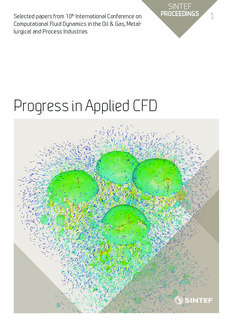| dc.contributor.author | Tabib, Mandar | |
| dc.contributor.author | Morud, John | |
| dc.contributor.author | Johansen, Stein Tore | |
| dc.contributor.author | Amini, Shahriar | |
| dc.date.accessioned | 2017-11-08T08:03:02Z | |
| dc.date.available | 2017-11-08T08:03:02Z | |
| dc.date.issued | 2015 | |
| dc.identifier.isbn | 978-82-536-1433-5 | |
| dc.identifier.isbn | 978-82-536-1432-8 | |
| dc.identifier.issn | 2387-4295 | |
| dc.identifier.uri | http://hdl.handle.net/11250/2464778 | |
| dc.description.abstract | Proper selection of a catalyst shape (or a particle shape) can improve the performance of a gas-solid packed bed reactor. The particle shape affects the packing structure and the transport phenomena within the packed bed. This information is not available for many non-spherical particle shapes which limit reactor design options. To enable catalyst and reactor design, a validated 3D Computational Fluid Dynamics (CFD)-Discrete Element Method (DEM) model has been developed to resolve the flow around these particles and to obtain information on the transport phenomena (pressure drop correlation and heat/mass transfer coefficient). The DEM is used to obtain realistic packing structures for different particle shapes, and the CFD is conducted on these DEM generated packing structure. However, the 3D CFD-DEM model cannot be applied on the whole reactor as it is computationally prohibitive. Hence, a multi-scale modelling approach is developed, wherein correlations obtained by the 3D CFD-DEM model from a representative 3D volume of the packed bed are used as closures in a 1D model for reactor design. The validations for all the models have been done. The multi-domain 1D particle-reactor model developed here is a combination of (1) a particle model for radial distribution of chemical species and temperature within a catalyst particle and (2) a 1D reactor model for mass and energy balance along the reactor. This 1D model is able to account for both intra-particle and inter-particle heat and mass transfer phenomena. The proposed multi-scale modelling approach has been applied to select an appropriate oxygen carrier shape for a Chemical Looping Combustion (CLC) packed bed reactor. This work compares the performance of different oxygen carrier shapes (fluted ring shape, cylindrical pellet shape and spherical shape) in terms of reactor operation. The simulations are used to recommend a pellet shape that offers least pressure drop, highest conversion and no early fuel slip for efficient CO2 capture. | nb_NO |
| dc.description.sponsorship | ACKNOWLEDGEMENT. A POP-SEP funding from SINTEF has been used for the 1D particle-reactor model software development. The multi-scale model development has been carried out as a part of the DemoCLOCK project, which is an EU FP7 funded project under the ENERGY.2010.6.1-1 programme. | nb_NO |
| dc.language.iso | eng | nb_NO |
| dc.publisher | SINTEF Academic Press | nb_NO |
| dc.relation.ispartof | Selected papers from 10th International Conference on Computational Fluid Dynamics in the Oil & Gas, Metallurgical and Process Industries | |
| dc.relation.ispartofseries | SINTEF Proceedings;1 | |
| dc.subject | Chemical looping combustion | nb_NO |
| dc.subject | Catalyst design | nb_NO |
| dc.subject | Packed bed reactor | nb_NO |
| dc.subject | Multi-scale modelling | nb_NO |
| dc.subject | CO2 capture | nb_NO |
| dc.subject | Discrete Element Modelling | nb_NO |
| dc.subject | CFD | nb_NO |
| dc.title | A multi-scale model for oxygen carrier selection and reactor design applied to packed bed chemical looping combustion | nb_NO |
| dc.type | Chapter | nb_NO |
| dc.description.version | publishedVersion | nb_NO |
| dc.rights.holder | © 2015 SINTEF Academic Press | nb_NO |
| dc.subject.nsi | VDP::Technology: 500 | nb_NO |
